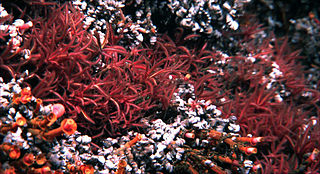
Alvinella pompejana, the Pompeii worm, is a species of deep-sea polychaete worm. It is an extremophile found only at hydrothermal vents in the Pacific Ocean, discovered in the early 1980s off the Galápagos Islands by French marine biologists.

The Alvinellidae are a family of small, deep-sea polychaete worms endemic to hydrothermal vents in the Pacific Ocean. Belonging to the order Terebellida, the family contains two genera, Alvinella and Paralvinella; the former genus contains two valid species and the latter eight. Members of the family are termed alvinellids.

Jean-Baptiste de Laubier, known professionally as Para One, is a French electronic music producer and film director.
Cordesia provannoides is a species of sea snail, a marine gastropod mollusk in the family Provannidae.
Desbruyeresia cancellata is a species of sea snail, a marine gastropod mollusk in the family Provannidae.
Desbruyeresia melanioides is a species of sea snail, a marine gastropod mollusk in the family Provannidae.

Ifremeria nautilei is a species of large, deepwater hydrothermal vent sea snail, a marine gastropod mollusk in the family Provannidae, and the only species in the genus Ifremeria. This species lives in the South Pacific Ocean

Acrocirridae is a family of polychaete worms. Acrocirrids are detritivores, catching falling particles with numerous long prostomial tentacles. There are eight known genera, and at least 21 described species and subspecies within the Acrocirridae. The acrocirrids are primarily benthic (seabed-dwelling) animals, but at least two genera appear to have evolved or adapted to a pelagic (free-swimming) habitat.

Orbiniidae is a family of polychaete worms. Orbiniids are mostly unselective deposit feeders on marine detritus. They can be found from the neritic zone to abyssal depths.

Amphinomidae, also known as the fireworms, bristle worms or sea mice, are a family of marine polychaetes, many species of which bear chaetae mineralized with carbonate. The best-known amphinomids are the fireworms, which can cause great pain if their toxin-coated chaetae are touched or trodden on. Their relationship to other polychaete groups is somewhat poorly resolved.
Jacques Forest was a French carcinologist.

Eudactylina is a genus of copepods. They parasitise elasmobranch fishes.
Protocotyle euzetmaillardi is a species of monogenean of the family Hexabothriidae.

The Shinkai 2000 (しんかい) was a crewed research submersible that could dive up to a depth of 2,000 meters. It was completed in 1981 and until 1991 it had the greatest depth range of any crewed research vehicle in Japan. The Shinkai 2000 was owned and run by the Japan Agency for Marine-Earth Science and Technology (JAMSTEC) and it was launched from the support vessel Natsushima.

Chrysopetalidae is a family of polychaete worms. The body is short or elongated, with few or numerous segments. All segments bear on their dorsal side a fan or a transverse row of paleae. The cephalic lobe has tentacles and eyes and the buccal segment has two or four tentacular cirri on each side. The parapodia are uniramous or biramous, with dorsal cirri upon all segments. The ventral bristles are compound.
Eunoe alvinella is a scale worm described from a specimen collected at a depth of 2725 m on the East Pacific Rise.

Peinaleopolynoe is a genus belonging to the family Polynoidae. Members of this genus generally live in nutrient-rich environments in the deep sea, such as whale fall, which is the reason for their name.
Cossuridae is a monotypic family of polychaetes belonging to the class Polychaeta. Its sole accepted genus is Cossura.
Prionospio is a genus of annelids belonging to the family Spionidae.

Amphicteinae is a subfamily of polychaete worms in the family Ampharetidae. It was originally established as a tribe, with eight genera, but was elevated to subfamily-level with a reduced number of genera in 2020. Two species, Hypaniola kowatewskii and Hypania invalida, are known to feed on blue-green algae.











